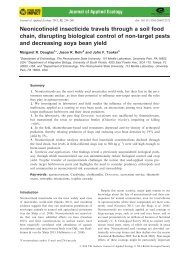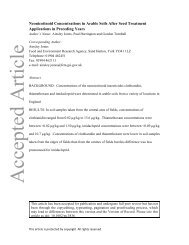g62-encyclopaedia-of-pests-and-natural-enemies-in-field-crops
g62-encyclopaedia-of-pests-and-natural-enemies-in-field-crops
g62-encyclopaedia-of-pests-and-natural-enemies-in-field-crops
- No tags were found...
You also want an ePaper? Increase the reach of your titles
YUMPU automatically turns print PDFs into web optimized ePapers that Google loves.
M<strong>in</strong>or <strong>and</strong>/or emerg<strong>in</strong>g <strong>pests</strong>M<strong>in</strong>or <strong>and</strong>/or emerg<strong>in</strong>g <strong>pests</strong>Other flea beetlesCrops affectedCereals✔ Oilseeds✔ Vegetable brassicasPotatoesCarrotsAlliumsPeasField beans✔ Sugar beetLettuce© Frank PorchTurnip flea beetle© Rothamsted Research LtdFlea beetle damage tosugar beetA number <strong>of</strong> flea beetles, <strong>in</strong>clud<strong>in</strong>g Wessex, striped<strong>and</strong> turnip flea beetles, cause occasional cropdamage. Phyllotreta species can be very damag<strong>in</strong>g<strong>pests</strong> <strong>of</strong> seedl<strong>in</strong>g crucifers, for example, swede <strong>and</strong>rocket.The Wessex flea beetle is <strong>of</strong> <strong>in</strong>creas<strong>in</strong>g importance <strong>in</strong>southern Engl<strong>and</strong> <strong>and</strong> is most likely to damage earliersownoilseed rape <strong>crops</strong>, especially if they are slow togrow away <strong>in</strong> September. Crops can be severelychecked.The striped <strong>and</strong> turnip flea beetles are pr<strong>in</strong>cipally <strong>pests</strong><strong>of</strong> spr<strong>in</strong>g brassicas, <strong>of</strong> which later-sown <strong>crops</strong> aremost susceptible; however, any crop may be at risk ifgrowth is checked by sunny, dry weather.Adult beet or mangold flea beetles can cause seriousdamage to the upper or lower surface <strong>of</strong> cotyledons,leaves <strong>and</strong> petioles <strong>of</strong> sugar beet. They overw<strong>in</strong>ter <strong>in</strong>sheltered spots (<strong>field</strong> marg<strong>in</strong>s or hedges) <strong>and</strong> emerge<strong>in</strong> spr<strong>in</strong>g. Eggs are laid <strong>in</strong> late spr<strong>in</strong>g <strong>and</strong> larvae feedon roots before pupat<strong>in</strong>g but the damage is caused byadult feed<strong>in</strong>g <strong>in</strong> the spr<strong>in</strong>g. They are most damag<strong>in</strong>gwhen they are present <strong>in</strong> large numbers, <strong>in</strong> cold, dry,sunny weather, <strong>and</strong> when soil temperatures are low<strong>and</strong> plant growth is slow.L<strong>in</strong>seed is also particularly susceptible to flea beetles.All <strong>of</strong> these beetles are smaller than the cabbagestem flea beetle (page 21).Pygmy beetle (Atomaria l<strong>in</strong>earis)Crops affectedCerealsOilseedsVegetable brassicasPotatoesCarrotsAlliumsPeasField beans✔ Sugar beetLettuce© Rothamsted Research LtdPygmy beetleCrops affected✔ CerealsOilseedsVegetable brassicasPotatoesCarrotsAlliumsPeasField beansSugar beetLettuceA small, elongate beetle <strong>of</strong> 2 mm <strong>in</strong> length, the pygmybeetle can damage sugar beet seedl<strong>in</strong>gs. Damage afterthe six true leaf stage is rarely <strong>of</strong> economic significance.Beetle bites on the root <strong>and</strong> hypocotyl cause small blackpits, which may allow <strong>in</strong>vasion by parasitic fungi. Severedamage can destroy the vascular tissue, caus<strong>in</strong>g theseedl<strong>in</strong>g to collapse. Cotyledons <strong>and</strong> leaves may also beeaten, leav<strong>in</strong>g irregular-shaped holes.The adults overw<strong>in</strong>ter <strong>in</strong> the soil <strong>and</strong> survive on beetcrowns left after harvest. In spr<strong>in</strong>g, they move to the soilsurface <strong>and</strong> fly on warm, still days from May onwards tocolonise new beet <strong>field</strong>s. In dry weather, the beetlesmove deep <strong>in</strong>to the soil. In humid weather, they move tothe soil surface <strong>and</strong> feed on the hypocotyl <strong>and</strong> leaves.Eggs are laid <strong>in</strong> late spr<strong>in</strong>g <strong>and</strong> summer <strong>and</strong> the larvaefeed on roots <strong>of</strong> well grown plants, caus<strong>in</strong>g little damage.Seedl<strong>in</strong>gs are most sensitive to damage from adults <strong>in</strong><strong>field</strong>s where beet is grown <strong>in</strong> close rotation or where<strong>crops</strong> are <strong>in</strong>fested early from adjacent <strong>field</strong>s with beetthe previous year. Rotation is usually the most effectivecontrol.Wheat shoot beetle (Helophorus nubilus)The wheat shoot beetleis an occasional pest <strong>of</strong>w<strong>in</strong>ter cereals follow<strong>in</strong>g agrass rotation.The larvae feed at thebase <strong>of</strong> the shoot,caus<strong>in</strong>g the plant orcentral leaves to yellow<strong>and</strong> die.© Dr Christoph Benisch – kerbtier.deDamage is usually seen Wheat shoot beetlefrom January to Marchbut can be avoided by leav<strong>in</strong>g a sufficient <strong>in</strong>tervalbetween plough<strong>in</strong>g grass <strong>and</strong> drill<strong>in</strong>g the crop – amonth should be sufficient under most conditions.39Pests: BeetlesPests: Beetles40




